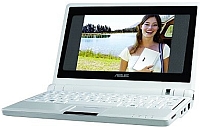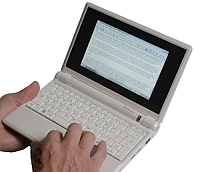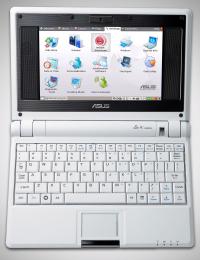Hey, it's Christoph Derndorfer from OLPC Austria speaking. It's been quite some time since I've last submitted a story but I'll do my best to come up with more articles in the foreseeable future.
The reason why I'm writing these lines is that the first reviews of the the Asus eee PC have recently been published and so I feel it's a good time to take a look at the current state of things.
I don't think it's really necessary to introduce the Asus eee PC to anyone reading this website. However if I had to explain the eee PC in one sentence I'd probably say something along the lines of
"it's Asus' first shot at the utlra low-cost notebook market"With that sentence we're already at one of the core topics surrounding that white little fella. It's obvious to anyone that the four different eee PC 701 models announced up to now (though from what I gather only one of them is readily available at the moment) are only the start and we're very likely to see more variations, updated models and eee PC v2s in the foreseeable future.
As previously highlighted in Wayan's story the main differences between the various models are the size of the RAM (256MB to 1GB), the size of the flash mass-storage (2GB to 8GB), the camera and the batteries. Compare that to the OLPC project and its "one size fits all" approach and you'll realize that Asus offers more choice, both in terms of the hardware and the price per unit.
Don't get me wrong, I'm fairly convinced that OLPC and Quanta would be more than happy to offer built-to-order options once an entity (be it a country or Coca Cola on a CSR trip) purchases a certain amount of X0s. Say Brazil only agrees to buy X0s if their units come with 2GB of flash. If I were OLPC or Quanta I'd ask them to pay the additional cost and happily send out a press release telling everyone that another country has just signed on.
Having that single product made sense back when Negroponte still believed that everyone would be more than happy to buy 1 million X0s per purchase. But these time they're changing and today with G1G1, give many and minimum purchase quantities basically having being eliminated things are very different. Today OLPC might only be competing with Asus but 6...12...18 months from now there'll be even more choice when it comes to low-cost computing solutions for both the developing and the developed world.
And while Intel will be quietly trying to make the X0-2 a device that has Intel inside many other companies will be working on similar products. The reason for that development is that OLPC was a real wake-up call for anyone in the ICT industry. It made many people realize that low-cost computing is a huge market that most companies were happy to ignore in the past. It's not that hard to imagine that 2 or 3 years down the road other major players such as Dell, HP and Acer will have joined Asus in the race to sell products to the next billion users.

Now what else is different if you compare the Eee PC and the X0? For one thing Microsoft seems to have less trouble getting Windows to run on the 701 because apparently they're working on a slimmed-down Vista that's specifically targeted at that machine. (At least that's what the rumour mill is saying.) Plus Asus is already offering Windows XP drivers and soon we're going to see 701s being delivered with a pre-installed WinXP.
Again, don't get me wrong: I don't think that running Vista (or anything close to it) on a 900MHz CPU with less than 2GB of RAM is going to be any fun. But according to various news reports that's only the first step in Microsoft's current quest when it comes to finding a more healthy Windows-diet. In mid-October it was reported that project "MinWin" isn't quite ready at the moment but could be a core component of the upcoming Windows 7 (formerly codenamed Vienna).
Now if you look at the big picture this indicates that going forward Microsoft also believes in slimmer and more targeted operating systems. Today Vista a la eee, tomorrow Vista a la classmate and afterwards... Vista a la X0-2? Again what I'm trying to say here is that people are realizing that the market for low-cost computing solution is so huge and varied that there'll be plenty of opportunities for different approaches on the operating system level. Which again means more choices for customers.
Another aspect of the eee PC project that hardly gets mentioned is that Asus seems to be very active when it comes to cooperation with the open-source world. According to the latest edition of Walter Bender's community-news this week OLPC is flying out Mike Fletcher to Taiwan to attend a FOSS conference and also meet up with lead eee PC developers. As he puts it on his blog:
"Asus will be presenting their EEEpc and their plans for creating a developer program around the platform. We really need to make sure that we're not duplicating effort across the platforms, and that the software and content used when going into schools is compatible."So who knows, maybe we'll soon see Sugar on the 701! Some people are going to be happy with Asus' custom Linux solution
which seems to be build on the Xandros distribution. Others might opt for WindowsXP. And the last guy may even go with Edubuntu. Again I think it's important to offer a variety of choices because that's what the market is going to demand.
In the end what I'm trying to say here is that the Asus eee PC project gives us a good glimpse of where things might be heading in the future when it comes to low-cost computing. Having said that I'm still convinced that the X0 is currently the best computing device for educating children in the developing world. And OLPC will always be remembered for making the world aware of the demand for low-cost computing.
However Asus and others are quickly learning and catching up and soon they will have great devices for a variety of other low-cost ICT requirements. And I'm sure that OLPC could learn another trick or two from them...





"For one thing Microsoft seems to have less trouble getting Windows to run on the 701 because apparently they're working on a slimmed-down Vista that's specifically targeted at that machine"
From what I have read, one of the main reasons Vista is so bloated is that it has DRM baked into every part of the OS. So is Microsoft going to drop that out for the new, slim version? Seems rather unlikely.
What is overlooked is the possibility to increase the size of mass storage y via SD card, 4GB version costs less than USD 60,00.
CSR Trip? (Corp. Social Responsibility)
ICT Industry? (Int'l Computer Tech?)
Jargon, eh? No hyperlinks to embedded tags or even a google lookup?
Eduardo: I don't think that Vista's bloat can be attributed to a single "feature" such as DRM. It's just the result of a very long process that has lead to much of Microsoft's software being anything but slim'n'trim.
Luya: You're certainly right that the mass storage can be easily upgraded. However $60, $40 or even $20 for an SD card can add up to 30% of additional cost to a single X0 unit so I consider it rather prohibitive. If a country decides its X0s should have more storage then it will be both cheaper and more effective to simply have a 2GB flash module used during the manufacturing process.
DeadG: I apologize for not explaining those terms and will try to do so in the future. However with the OLPCnews readership tending to be very tech-savy I thought that especially a term such as "ICT" (information and communication technology) wouldn't need an explanation.
From the start I have never believed for a moment that MS would allow the OLPC or anyone else to distribute millions of linux computers to the poor.
MS earns 60+ B$ a year from its monopoly. It must be willing to spend tens of billions a year to keep it. See for instance the willingness to spend billions (>4 B$) to delay and derail the EU requirement that they document their (CIFF) network protocols.
You can see here how this works:
http://www.theregister.co.uk/2007/11/01/mandriva_ceo_posts_open_letter_to_steve_ballmer/
Expect to see a MS Vista for XO and Classmates at any price (even if they have to graft Vista on Windows CE or *BSD). They would even be willing to pay for all the hardware upgrades necessary.
In my opinion, little can be learned from MS software. But that is not a bug, but a feature in the eyes of MS.
Winter
ChristophD:
"Eduardo: I don't think that Vista's bloat can be attributed to a single "feature" such as DRM."
Correct, which is why I did not say that DRM was **the** reason, but rather that it was one of the **main** reasons.
People.. You must admit that the ASUS EEE PC is on hands of many people aroud the world. Regular people. The market will find the way to bring a new era of cheap and easy mobile computing. Many of you have ever touched , used or owned a OLPC ? Regards
I fear that OLPC and Quanta are blowing their chances to create the T-model of cheap/children laptops.
From the reviews, the eee machine looks like a more than worthy contender for the XO. Even with its hardware being inferior in some aspects compared to the XO, it may hit the XO hard. From the perspective of a would-be individual small/cheap laptop owner: It is the same price as the XO (G1G1=USD400, eeePC~400), it looks it is to become widely available everywhere in the world. (G1G1 is limited to America).
Although, I love the original idea, I am afraid the OLPC strategy is failing. I know, I know, this is an education project not a generic purpose laptop project but: if they could have shown a commercially successful laptop first, and then a "sugarized" one, they wouldn't have to explain anything to the would-be educational buyers. The success of the adult laptop would have spoken for itself. I am quite sure that an adult-looking XO for USD250 would kick ass.
I wish there was word from Quanta that they are working on the adult/public version of the XO and it will become available at date X.
The OLPC strategy is not failing - it has succeeded in creating a new category of portable computer - a category cheap enough for use in the developing world. I'm just wondering if the OLPC software stack can run on the Eee?
Just because the eee is already in the hands of many "regular people" around the world doesn't mean the OLPC project is failing. ASUS is a for-profit company, and while they admit they were inspired by the OLPC, their main buyers (and intended audience) are adults in developed nations. OLPC is a non-profit dedicated to providing low cost computing to children in developing nations (who are also "regular people," incidentally). So far, OLPC is very successful in that niche. You can't judge a non-profit's success by whether or not you can hop over to Best Buy and pick up their product. While producing an adult machine first might have helped OLPC's profit margin, it wouldn't necessarily have helped their mission.
[As an aside, I'm typing this post from an eee, which I also used to participate online in OLPC's "give 1 get 1" program. The eee is a handy little machine, but the XO seems much more revolutionary, not only because of its target audience, but also because of innovative thoughtfulness that went into its design (durability, non-toxic battery and other parts, multiple powering options and low power draw, readable screen in bright sunlight, mesh network, etc.)]